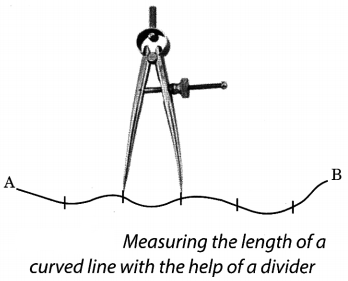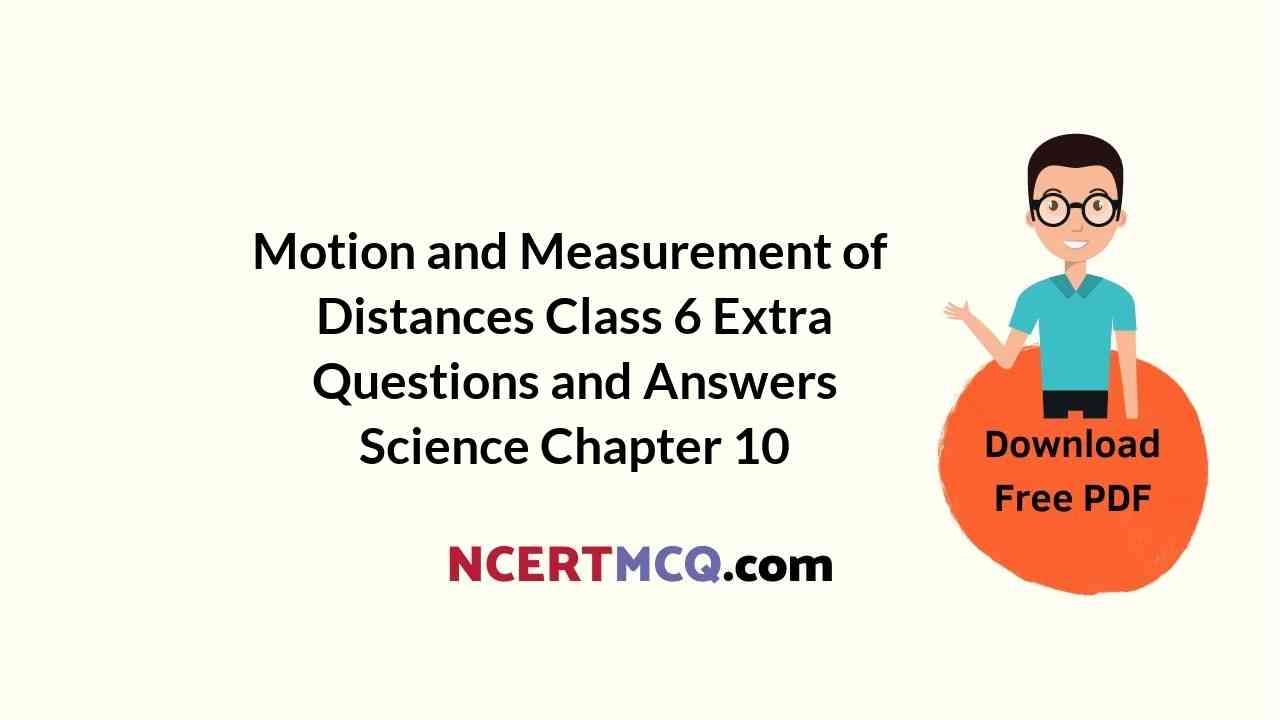In this page, we are providing Motion and Measurement of Distances Class 6 Extra Questions and Answers Science Chapter 10 pdf download. NCERT Extra Questions for Class 6 Science Chapter 10 Motion and Measurement of Distances with Answers will help to score more marks in your CBSE Board Exams. https://ncertmcq.com/extra-questions-for-class-6-science/
Class 6 Science Chapter 10 Extra Questions and Answers Motion and Measurement of Distances
Extra Questions for Class 6 Science Chapter 10 The Living Organisms and Their Surroundings with Answers Solutions
Motion and Measurement of Distances Class 6 Extra Questions Very Short Answer Type
Class 6 Science Chapter 10 Extra Questions Question 1.
Name the invention which made a great change in modes of transport.
Answer:
Invention of wheel.
Motion And Measurement Of Distances Class 6 Extra Questions Question 2.
What kind of motion produce sound?
Answer:
Vibratory motion
Ncert Class 6 Science Chapter 10 Extra Questions Question 3.
What is the full form of SI unit?
Answer:
International System of unit.
Motion And Measurement Of Distances Class 6 Extra Questions And Answers Question 4.
Name the ancient modes of measurement.
Answer:
Handspan, cubit, finger, fathom, pace, etc.
Class 6 Science Ch 10 Extra Questions Question 5.
Which power was used to pull vehicles in ancient times?
Answer:
Animal power
Motion And Measurement Of Distances Class 6 Worksheet With Answers Question 6.
Name the two parts which must be mentioned to state the result of a measurement.
Answer:
Magnitude and unit.
Motion And Measurement Of Distances Class 6 Questions And Answers Question 7.
What type of measuring device would you use to measure the girth of a tree?
Answer:
Measuring tape
Measurement And Motion Class 6 Questions And Answers Question 8.
Which system of measurement is used now-a-days?
Answer:
SI system
Measurement And Motion Class 6 Questions Question 9.
Name the SI unit of length.
Answer:
Metre (m)
Chapter 10 Science Class 6 Extra Questions Question 10.
Which unit of length is used for measuring very small distance?
Answer:
Millimetre (mm)
Class 6 Chapter 10 Science Extra Questions Question 11.
Which unit of length is used for measuring larger distances?
Answer:
Kilometre (km)
Motion And Measurement Of Distances Extra Questions Question 12.
Which unit of measurement is used to measure the quantity of milk?
Answer:
Litre or millilitre
Motion And Measurement Of Distances Question Answer Question 13.
Give an example of circular motion.
Answer:
The movement of earth around the sun.
Class 6 Science Chapter 10 Extra Questions And Answers Question 14.
What type of motion do the vehicle on a straight road have?
Answer:
Rectilinear motion
Class 6 Science Chapter 10 Extra Question Answer Question 15.
What type of motion is shown by the wheel of a bicycle?
Answer:
Circular motion
Question 16.
State the type of motion exhibited by a falling stone.
Answer:
Rectilinear motion
Question 17.
Give one example of rotational motion.
Answer:
The spinning of earth on its axis.
Question 18.
Name two devices which are commonly used for measuring length.
Answer:
Ruler and measuring tape.
Question 19.
What is a fixed quantity called?
Answer:
Unit
Question 20.
When was SI unit recommended by the general conference of weights and measures?
Answer:
1960
Motion and Measurement of Distances Class 6 Extra Questions Short Answer Type
Question 1.
What is measurement?
Answer:
Measurement is defined as the comparison of some unknown quantity with a fixed quantity of the same kind.
Question 2.
What is a standard unit?
Answer:
A standard unit is a standard measure that has some definite and convenient quantity in it so that it remains the same wherever and by whoever it is used.
Question 3.
Define rest and motion.
Answer:
Rest: The object which do not change their positions with the time are said to be at rest.
Motion: The object which change their position with time are said to be in motion.
Question 4.
Why it is important to know how far a place is?
Answer:
It is important to know how far a place is, so that we can have an idea how we are going to reach that place, i.e., by walking, taking a bus or train, a ship, an aeroplane or even a spacecraft.
Question 5.
What is meant by rectilinear motion? Give two examples.
Answer:
The motion in a straight line is called rectilinear motion. For example, motion of a bullet fired from gun and motion of a stone falling down from a height.
Question 6.
Define periodic motion. State two examples.
Answer:
The motion which repeats itself after regular intervals of time, is called periodic motion. The two examples are
(i) revolution of moon around the earth and
(ii) revolution of earth around the sun.
Question 7.
Give one example each of the following types of motion:
(a) Linear
(b) Rotational
(c) Circular
(d) Periodic
Answer:
(a) Linear: Motion of a falling stone
(b) Rotational: The motion of a spinning top
(c) Circular: The movement of moon around the earth
(d) Periodic: The motion of a second’s hand of a watch
Question 8.
How is time related to motion?
Answer:
Motion and time are inseparable part. Motion is change in the position of an object with respect to time. In absence of time it will be hard to determine the motion of an object.
Motion and Measurement of Distances Class 6 Extra Questions Long Answer Type
Question 1.
What is meant by a standard unit of measurement? Why is it necessary to have standard units of measurement? Name the SI unit of length. Write its symbol.
Answer:
A unit of measurement which has a fixed value and does not change from person to person or place to place, is called a standard unit of measurement. It is necessary to have standard units of measurements for the sake of uniformity in measurement. The SI unit of length is metre. Its symbol is m.
Question 2.
State the procedures for the measurement of length using a metre scale.
Answer:
While measuring length using a metre scale, we must follow the steps given below:
- The ruler should be kept along the length of the object so that the zero mark on the ruler coincides with the one end of the object. The ruler should be parallel to one of the edges.
- While taking the measurement, the eyes should be correctly positioned. The eye must be exactly vertically above the point where the measurement is to be taken.
- If the edge of the ruler is worn out or broken, the measurement should be taken from any other full mark of the ruler.
Question 3.
What are the reasons for which SI system is recommended?
Answer:
SI system is recommended for the following reasons:
- It is standardised unit, therefore, it is accepted universally.
- Even minute measurements are possible in this system.
- Interconversions within the system make calculation easy.
- The units do not change with time or place.
Question 4.
What is meant by (a) circular motion and (b) rotational motion? Give two examples of circular motion and two examples of rotational motion.
Answer:
(a) Circular motion: When an object moves along a circular path, it is called a circular motion.
Example:
(i) The movement of moon around the earth
(ii) The movement of earth around the sun
(b) Rotational motion: When an object twines or spins about a fixed axis, it is called rotational motion.
Example:
(i) The motion of a spinning top
(ii) The spinning of earth on its axis.
Question 5.
How will you measure the length of any curved line using a divider?
Answer:
Let there be a curved line AB (Fig. 10.8). Open the legs of the divider to cover some convenient distance. Place one leg of the divider at one end of the curved line and put the other leg on the line.

Now count the number of times the divider has to be taken along the line to cover the entire length of line AB. At the end, some portion of line may be left out, being less than the distance between the two legs. Measure it separately by adjusting the divider. Multiply the number of complete steps by the distance between the two legs. Add the length of the remaining distance to this length. You will get the total length of the curved line.
Motion and Measurement of Distances Class 6 Extra Questions HOTS
Question 1.
If you are given a woollen thread and a cotton thread and asked to measure the length of a curved line which thread will you prefer?
Answer:
Cotton thread will be preferred over woollen thread as it neither sinks nor extends and will give comparatively accurate result.
Question 2.
Would the distance of the stone from your hand will be same when you whirl it around? Give reason.
Answer:
Yes because the length of the string with which we have hold the stone is not changing.
Question 3.
Can you think of some objects which are exhibiting more than one type of motion? Also mention the type of motion in them.
Answer:
A cycle shows both rotational as well as rectilinear motion.
Motion and Measurement of Distances Class 6 Extra Questions Value-Based (VBQs)
Question 1.
Rahul and Sonia were playing with blocks and each of them made a train out of them. Both of them thought of measuring the length of the train using their handspan. By that time Rahul’s friend Anupam came and suggested them to measure with a measuring tape for fair result.
(a) What is a handspan?
(b) Why Anupam asked both of them to use measuring tape?
(c) What value of Anupam is shown here?
Answer:
(a) The distance between the tip of the thumb and tip of the little finger of a fully stretched hand is called handspan.
(b) To get the accurate result which is not possible with the handspan.
(c) Anupam is an intelligent and active boy.
Question 2.
Ishika was asked by her teacher to measure the length of the line drawn on the blackboard. She immediately took out her scale to measure the line. But she noticed that the end of her scale is broken. She felt very sad and said to the teacher that she would not be able to measure the length of the line. Teacher consoled her and taught her a new method of measuring line using the same scale.
(a) What is a scale?
(b) Name devices that can be used to measure length.
(c) What new method of measuring line by using a broken scale was taught by Ishika’s teacher?
(d) What values of Ishika is shown here?
Answer:
(a) A straight strip of wood, metal or plastic used for drawing straight line and measuring length.
(b) Measuring tape and ruler.
(c) If the end of a scale is broken, one can use any full mark of the scale and then subtract the reading of this mark from the reading at the other end.
(d) She got nervous easily and sensitive.
